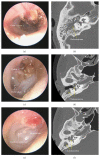Updates and knowledge gaps in cholesteatoma research
- PMID: 25866816
- PMCID: PMC4381684
- DOI: 10.1155/2015/854024
Updates and knowledge gaps in cholesteatoma research
Abstract
The existence of acquired cholesteatoma has been recognized for more than three centuries; however, the nature of the disorder has yet to be determined. Without timely detection and intervention, cholesteatomas can become dangerously large and invade intratemporal structures, resulting in numerous intra- and extracranial complications. Due to its aggressive growth, invasive nature, and the potentially fatal consequences of intracranial complications, acquired cholesteatoma remains a cause of morbidity and death for those who lack access to advanced medical care. Currently, no viable nonsurgical therapies are available. Developing an effective management strategy for this disorder will require a comprehensive understanding of past progress and recent advances. This paper presents a brief review of background issues related to acquired middle ear cholesteatoma and deals with practical considerations regarding the history and etymology of the disorder. We also consider issues related to the classification, epidemiology, histopathology, clinical presentation, and complications of acquired cholesteatoma and examine current diagnosis and management strategies in detail.
Figures








References
Publication types
MeSH terms
LinkOut - more resources
Full Text Sources
Other Literature Sources
Miscellaneous

